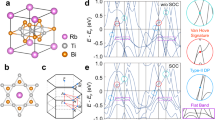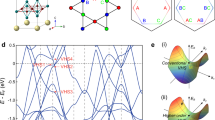Abstract
Electronic nematicity that spontaneously breaks rotational symmetry is a generic phenomenon in correlated quantum systems including high-temperature superconductors and the AV3Sb5 (A can be K, Rb or Cs) family of kagome superconductors. However, the underlying mechanism of nematicity in these systems is hard to identify because of its entanglement with other ordered phases. Recently, a family of titanium-based kagome superconductors ATi3Bi5 have been synthesized, where electronic nematicity occurs in the absence of charge order. It provides a platform to study nematicity in its pure form, as well as its interplay with orbital degrees of freedom. Here we reveal the band topology and orbital characters of the multiorbital RbTi3Bi5. We use polarization-dependent angle-resolved photoemission spectroscopy with density functional theory to identify the coexistence of flat bands, type-II Dirac nodal lines and non-trivial topology in this compound. Our study demonstrates the change in orbital character along the Fermi surface contributed by the kagome bands, implying a strong intrinsic interorbital coupling in the Ti-based kagome metals. Furthermore, doping-dependent measurements uncover the orbital-selective features in the kagome bands, which can be explained by d–p hybridization. Hence, interorbital coupling together with d–p hybridization is probably the origin of electronic nematicity in ATi3Bi5.
This is a preview of subscription content, access via your institution
Access options
Access Nature and 54 other Nature Portfolio journals
Get Nature+, our best-value online-access subscription
$29.99 / 30 days
cancel any time
Subscribe to this journal
Receive 12 print issues and online access
$209.00 per year
only $17.42 per issue
Buy this article
- Purchase on Springer Link
- Instant access to full article PDF
Prices may be subject to local taxes which are calculated during checkout




Similar content being viewed by others
Data availability
All data needed to evaluate the conclusions in the paper are present in the paper and/or the Supplementary Information. All other data that support the findings of this study are available from the corresponding authors upon reasonable request. Source data are provided with this paper.
Code availability
The band structures used in this study are available from the corresponding authors upon reasonable request.
References
Chuang, T.-M. et al. Nematic electronic structure in the ‘parent’ state of the iron-based superconductor Ca(Fe1–xCox)2As2. Science 327, 181–184 (2010).
Chu, J.-H. et al. In-plane resistivity anisotropy in an underdoped iron arsenide superconductor. Science 329, 824–826 (2010).
Chu, J.-H., Kuo, H.-H., Analytis, J. G. & Fisher, I. R. Divergent nematic susceptibility in an iron arsenide superconductor. Science 337, 710–712 (2012).
Rosenthal, E. P. et al. Visualization of electron nematicity and unidirectional antiferroic fluctuations at high temperatures in NaFeAs. Nat. Phys. 10, 225–232 (2014).
Kuo, H.-H., Chu, J.-H., Palmstrom, J. C., Kivelson, S. A. & Fisher, I. R. Ubiquitous signatures of nematic quantum criticality in optimally doped Fe-based superconductors. Science 352, 958–962 (2016).
Ando, Y., Segawa, K., Komiya, S. & Lavrov, A. N. Electrical resistivity anisotropy from self-organized one dimensionality in high-temperature superconductors. Phys. Rev. Lett. 88, 137005 (2002).
Hinkov, V. et al. Electronic liquid crystal state in the high-temperature superconductor YBa2Cu3O6.45. Science 319, 597–600 (2008).
Lawler, M. J. et al. Intra-unit-cell electronic nematicity of the high-Tc copper-oxide pseudogap states. Nature 466, 347–351 (2010).
Daou, R. et al. Broken rotational symmetry in the pseudogap phase of a high-Tc superconductor. Nature 463, 519–522 (2010).
Fernandes, R., Chubukov, A. & Schmalian, J. What drives nematic order in iron-based superconductors? Nat. Phys. 10, 97–104 (2014).
Keimer, B. et al. From quantum matter to high-temperature superconductivity in copper oxides. Nature 518, 179–186 (2015).
Kiesel, M. L. & Thomale, R. Sublattice interference in the kagome Hubbard model. Phys. Rev. B 86, 121105(R) (2012).
Kiesel, M. L., Platt, C. & Thomale, R. Unconventional Fermi surface instabilities in the kagome Hubbard model. Phys. Rev. Lett. 110, 126405 (2013).
Wang, W.-S., Li, Z.-Z., Xiang, Y.-Y. & Wang, Q.-H. Competing electronic orders on kagome lattices at Van Hove filling. Phys. Rev. B 87, 115135 (2013).
Yin, J.-X. et al. Negative flat band magnetism in a spin–orbit-coupled correlated kagome magnet. Nat. Phys. 15, 443–448 (2019).
Wu, X. et al. Nature of unconventional pairing in the kagome superconductors AV3Sb5. Phys. Rev. Lett. 127, 177001 (2021).
Kang, M. et al. Dirac fermions and flat bands in the ideal kagome metal FeSn. Nat. Mater. 19, 163–169 (2020).
Kang, M. et al. Twofold Van Hove singularity and origin of charge order in topological kagome superconductor CsV3Sb5. Nat. Phys. 18, 301–308 (2022).
Hu, Y. et al. Rich nature of Van Hove singularities in kagome superconductor CsV3Sb5. Nat. Commun. 13, 2220 (2022).
Yan, S., Huse, D. A. & White, S. R. Spin-liquid ground state of the S = 1/2 kagome Heisenberg antiferromagnet. Science 332, 1173–1176 (2011).
Han, T.-H. et al. Fractionalized excitations in the spin-liquid state of a kagome-lattice antiferromagnet. Nature 492, 406–410 (2012).
Han, T., Chu, S. & Lee, Y. S. Refining the spin Hamiltonian in the spin-1/2 kagome lattice antiferromagnet ZnCu3(OH)6Cl2 using single crystals. Phys. Rev. Lett. 108, 157202 (2012).
Fu, M., Imai, T., Han, T.-H. & Lee, Y. S. Evidence for a gapped spin-liquid ground state in a kagome Heisenberg antiferromagnet. Science 350, 655–658 (2015).
Liu, E. et al. Giant anomalous Hall effect in a ferromagnetic kagome-lattice semimetal. Nat. Phys. 14, 1125–1131 (2018).
Morali, N. et al. Fermi-arc diversity on surface terminations of the magnetic Weyl semimetal Co3Sn2S2. Science 365, 1286–1291 (2019).
Liu, D.-F. et al. Magnetic Weyl semimetal phase in a kagome crystal. Science 365, 1282–1285 (2019).
Ko, W.-H., Lee, P. A. & Wen, X.-G. Doped kagome system as exotic superconductor. Phys. Rev. B 79, 214502 (2009).
Ortiz, B. R. et al. New kagome prototype materials: discovery of KV3Sb5, RbV3Sb5, and CsV3Sb5. Phys. Rev. Mater. 3, 094407 (2019).
Ortiz, B. R. et al. CsV3Sb5: a ℤ2 topological kagome metal with a superconducting ground state. Phys. Rev. Lett. 125, 247002 (2020).
Chen, H. et al. Roton pair density wave and unconventional strong-coupling superconductivity in a topological kagome metal. Nature 559, 222–228 (2021).
Jiang, Y.-X. et al. Discovery of unconventional chiral charge order in kagome superconductor KV3Sb5. Nat. Mater. 20, 1353–1357 (2021).
Zhao, H. et al. Cascade of correlated electron states in the kagome superconductor CsV3Sb5. Nature 599, 216–221 (2021).
Nie, L. et al. Charge-density-wave-driven electronic nematicity in a kagome superconductor. Nature 604, 59–64 (2022).
Yang, H. et al. Titanium-based kagome superconductor CsTi3Bi5 and topological states. Preprint at https://arxiv.org/abs/2209.03840 (2022).
Werhahn, D. et al. The kagomé metals RbTi3Bi5 and CsTi3Bi5. Z. Naturforsch. B 77, 757–764 (2022).
Yang, H. et al. Superconductivity and orbital-selective nematic order in a new titanium-based kagome metal CsTi3Bi5. Preprint at https://arxiv.org/abs/2211.12264 (2022).
Li, H. et al. Electronic nematicity in the absence of charge density waves in a new titanium-based kagome metal. Nat. Phys. https://doi.org/10.1038/s41567-023-02176-3 (2023).
Damascelli, A., Hussain, Z. & Shen, Z.-X. Angle-resolved photoemission studies of the cuprate superconductors. Rev. Mod. Phys. 75, 473–541 (2003).
Yi, X.-W. et al. Large kagome family candidates with topological superconductivity and charge density waves. Phys. Rev. B 106, L220505 (2022).
Jiang, Y. et al. Screening promising CsV3Sb5-like kagome materials from systematic first-principles evaluation. Chinese Phys. Lett. 39, 047402 (2022).
Hecher, M. & Schmalian, J. Vestigial nematic order and superconductivity in the doped topological insulator CuxBi2Se3. npj Quantum Mater. 3, 26 (2018).
Fernandes, R. M., Orth, P. P. & Schmalian, J. Intertwined vestigial order in quantum materials: nematicity and beyond. Annu. Rev. Condens. Matter Phys. 10, 133–154 (2019).
Jiang, K., Hu, J., Ding, H. & Wang, Z. Interatomic Coulomb interaction and electron nematic bond order in FeSe. Phys. Rev. B 93, 115138 (2016).
Kresse, G. & Hafner, J. Ab initio molecular dynamics for liquid metals. Phys. Rev. B 47, 558 (1993).
Kresse, G. & Furthmüller, J. Efficiency of ab-initio total energy calculations for metals and semiconductors using a plane-wave basis set. Comput. Mater. Sci. 6, 15 (1996).
Kresse, G. & Furthmüller, J. Efficient iterative schemes for ab initio total-energy calculations using a plane-wave basis set. Phys. Rev. B 54, 11169 (1996).
Monkhorst, H. J. & Pack, J. D. Special points for Brillouin-zone integrations. Phys. Rev. B 13, 5188 (1976).
Mostofi, A. A. et al. wannier90: a tool for obtaining maximally-localised Wannier functions. Comput. Phys. Commun. 178, 685 (2008).
Lopez Sancho, M. P., Lopez Sancho, J. M., Sancho, J. M. L. & Rubio, J. Highly convergent schemes for the calculation of bulk and surface Green functions. J. Phys. F: Met. Phys. 15, 851 (1985).
Acknowledgements
Work at the Paul Scherrer Institut was supported by the Swiss National Science Foundation under grant no. 200021_188413. X.W. was supported by the National Natural Science Foundation of China (grant no. 12047503). J.M. was supported by the Research Grants Council of Hong Kong via Early Career Scheme (21304023), the Collaborative Research Fund (C6033-22G), the Collaborative Research Equipment Grant (C1018-22E) and the National Natural Science Foundation of China (12104379). J.H. was supported by the Ministry of Science and Technology (grant no. 2022YFA1403901), the National Natural Science Foundation of China (grant no. NSFC-11888101) and the New Cornerstone Foundation.
Author information
Authors and Affiliations
Contributions
Y.H. and M.S. conceived the ARPES experiments. Z.Z. grew and characterized the crystals with guidance from H.C., H.Y. and H.-J.G. X.W. and C.L. performed the theoretical calculations and analysis with support from A.P.S. and J.H. Y.H. performed the ARPES experiments with help from J.M., M.R. and M.S. Y.Z. and J.L. performed the transport measurements with guidance from X.D. N.C.P. maintained the ARPES facilities at ULTRA, SIS. Y.H. analysed the data. Y.H. and X.W. wrote the paper with inputs from all authors.
Corresponding authors
Ethics declarations
Competing interests
The authors declare no competing interests.
Peer review
Peer review information
Nature Physics thanks the anonymous reviewers for their contribution to the peer review of this work.
Additional information
Publisher’s note Springer Nature remains neutral with regard to jurisdictional claims in published maps and institutional affiliations.
Supplementary information
Supplementary Information
Supplementary Sections 1–8 and Figs. 1–8.
Source data
Source Data Fig. 1
Magnetic susceptibilities, temperature-dependent resistivity and DFT-calculated band dispersions of RbTi3Bi5.
Source Data Fig. 2
DFT-calculated electronic structure and ARPES spectra for the flat bands.
Source Data Fig. 4
Doping-dependent EDCs and orbital-resolved DFT-calculated band dispersion.
Rights and permissions
Springer Nature or its licensor (e.g. a society or other partner) holds exclusive rights to this article under a publishing agreement with the author(s) or other rightsholder(s); author self-archiving of the accepted manuscript version of this article is solely governed by the terms of such publishing agreement and applicable law.
About this article
Cite this article
Hu, Y., Le, C., Zhang, Y. et al. Non-trivial band topology and orbital-selective electronic nematicity in a titanium-based kagome superconductor. Nat. Phys. 19, 1827–1833 (2023). https://doi.org/10.1038/s41567-023-02215-z
Received:
Accepted:
Published:
Issue Date:
DOI: https://doi.org/10.1038/s41567-023-02215-z
This article is cited by
-
Rotation rearranges electrons
Nature Physics (2023)
-
Electronic landscape of kagome superconductors AV3Sb5 (A = K, Rb, Cs) from angle-resolved photoemission spectroscopy
npj Quantum Materials (2023)
-
Flat bands, non-trivial band topology and rotation symmetry breaking in layered kagome-lattice RbTi3Bi5
Nature Communications (2023)



